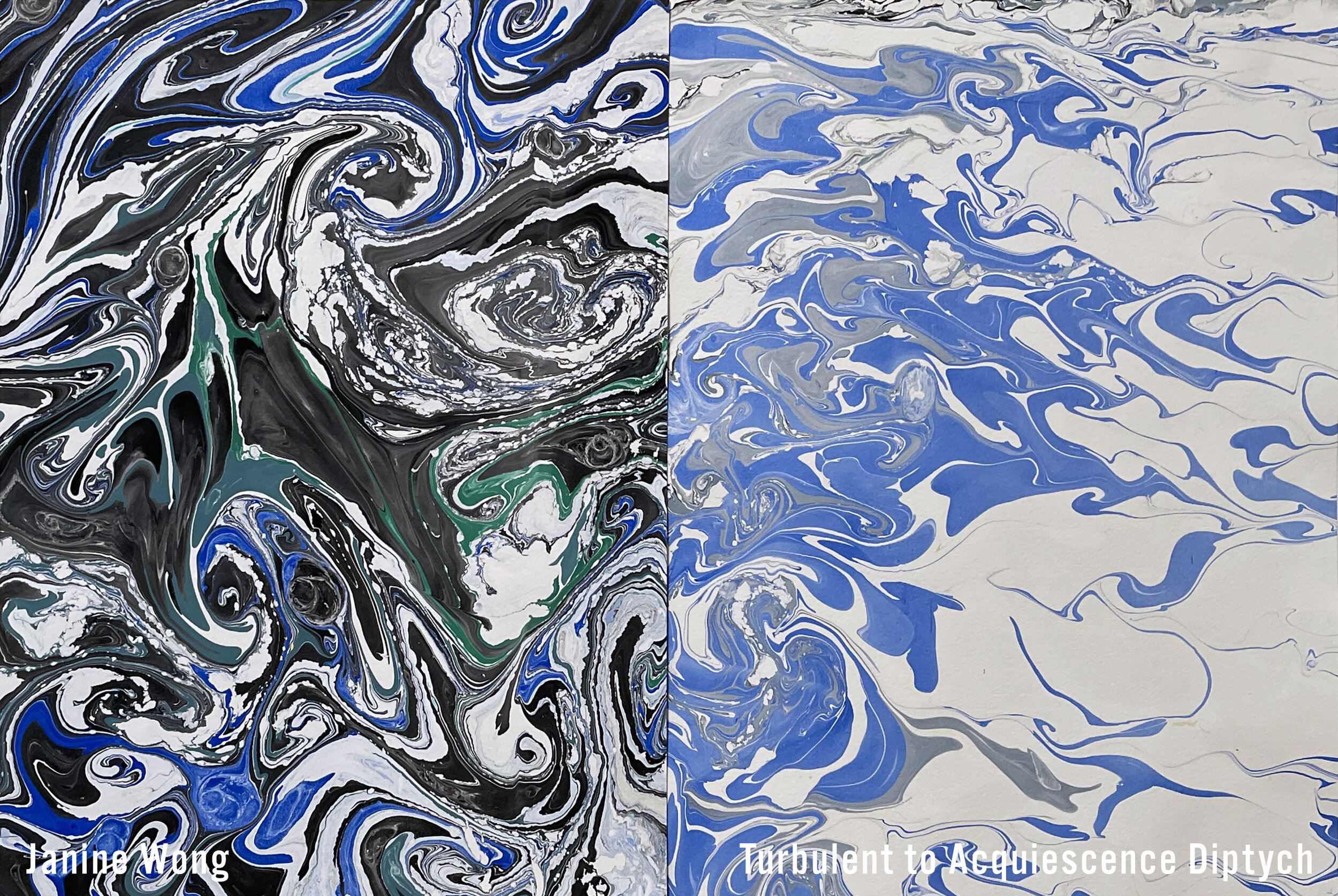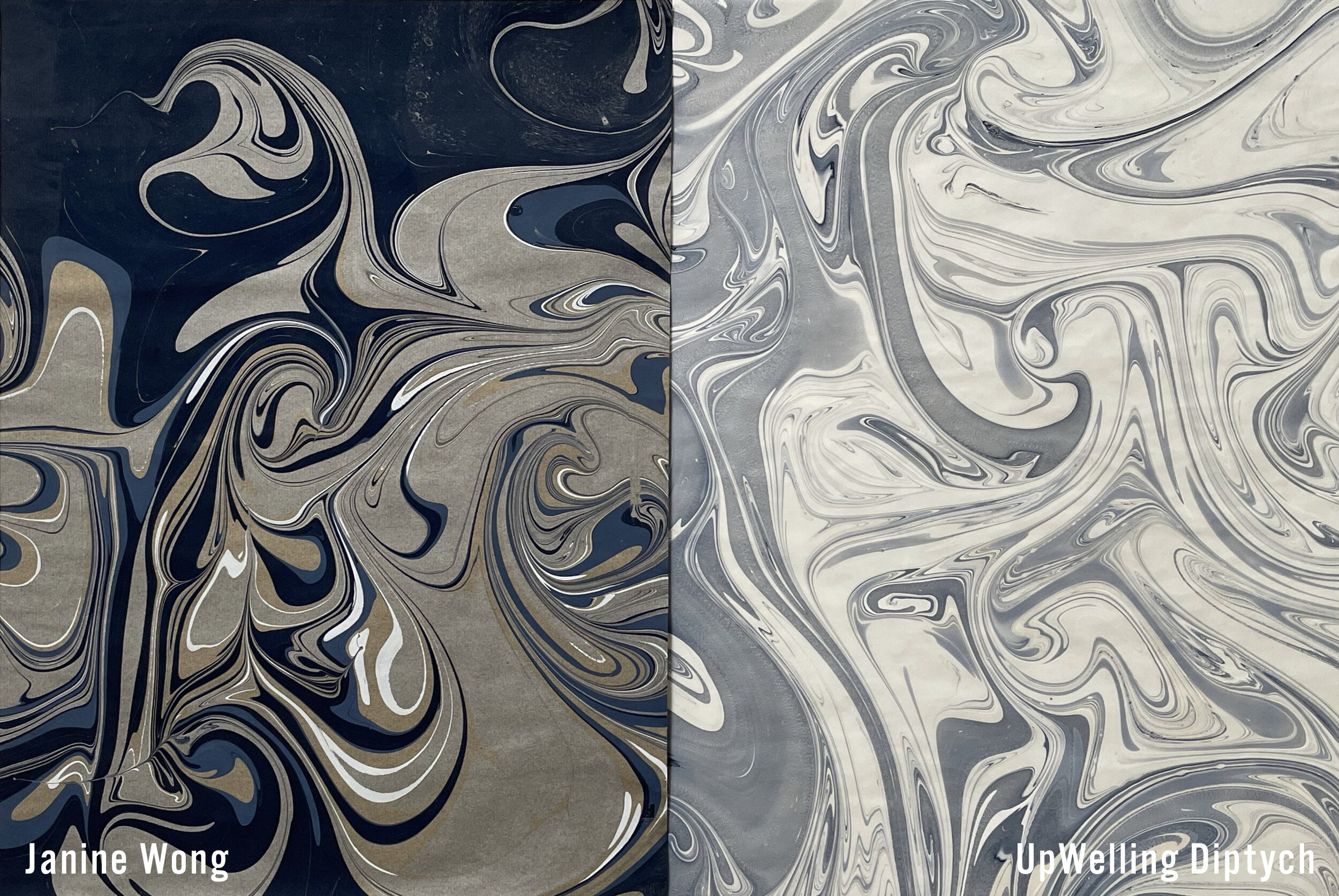
Submesoscale Soup
by Janine Wong & Jing he
Above: “Turbulent to Acquiescence Diptych” — Janine Wong
Submesoscale Soup illustrates the natural and the technological/analytical components to science research.
MEDIUM
Monotype marbling
PIECES
Artist's book 13 x 17 ½ inches consisting of twelve spreads or folios housed in a clamshell box
TOPIC
“Submesoscale soup,” a type of chaotic but beautiful mix of ocean currents
LOCATION
Research off the coast of California, phenomena found globally
"UpWelling Diptych" — Janine Wong
"Turbulent to Acquiescence Diptych" — Janine Wong
The first Step
If you fly over the California coast and look down at the ocean, you might see a “submesoscale soup” of currents. This is not a soup that would be particularly tasty—most people would find it too salty to eat—but it is rich in nutrients and is important for sustaining marine life. Furthermore, this soup is named because it is a mess of turbulent motions (at the “submesoscale” size of 1-10km) mixed together. Part of Jing’s research is to untangle the different types of currents in this soup and to predict them using computer simulations and machine learning. Machine learning uses computer algorithms to search through large amounts of data to find relationships and patterns that might be hard to recognize with the human eye. In particular, Jing is interested to learn more about how these currents both transport nutrients to fuel life, and how they help sequester carbon in the ocean.

Stirring the Ingredients
Above: “UpWelling Diptych” — Janine Wong
Through discussions and brainstorming sessions, we realized that a theme in Jing’s research is the unseen. The submesoscale soup that Jing studies is hard for the average person to visualize in real life because the ocean is so vast and these currents are flowing over scales larger than what humans are used to (1-10km). As a result, you will not be able to see this “soup” from the beach. Moreover, the machine learning algorithms Jing uses can also feel abstract, intangible, and difficult to picture. Luckily Janine—who was inspired by scientific illustration books from the turn of the century such as Anna Atkins, Ernest Haeckel, and Margaret Gatty—was up for the challenge in discovering how to describe the invisible in a way that depicts the beauty of unseen science and scientific research.
After experimenting with different media and ways of story-telling, we landed on creating an artist’s book in the form of a recipe with illustrations done through marbling. The cooking analogies provide a familiar way to comprehend how a complex system—a patch of ocean—is the result of many different ingredients mixed and stirred and heated and cooled. Submesoscale soup is chaotic and messy, but it is not so mysterious after breaking it down into its basic ingredients and physical processes that are each more tangible and understandable. Jing follows these steps in her research to recreate versions of this soup in computer simulations, which allows her to better study them in detail.
“Instability Submesoscale Mesoscale” — Janine Wong
Ready to eat
Marbling turned out to be a natural medium for this project, both for its realisticness and symbolism. It turns out that the best way to illustrate water is to use water. The print process of marbling consists of suspending paint in a tank of water mixed with carrageenan, which is made from seaweed and serves as a reminder that we are connected to the ocean and the early algae photography of Anna Atkins. The marbling tank filled with seaweed and water simulates a mini ocean, and in it we create motions to represent the different types of currents we want to capture on print. In addition, chemicals are used to vary surface tension and generate divergent and convergent flows, which push paint around into concentrated filaments. Colors and textures are also employed to convey a sense of depth and visual hierarchy. While marbling is used to convey the natural fluid state of the ocean, sewing adds different materials and represents the human technology (computer algorithms and machine learning decision trees) used to understand the complicated intricate ocean system. Together, the resulting mixed media prints illustrate the natural and the technological/analytical components to science research.
Janine & Jing
To find out more about the artist and scientist who are behind this project, visit their section of the Artists & Scientists page via the link below.
